AI in Indoor Water Conservation
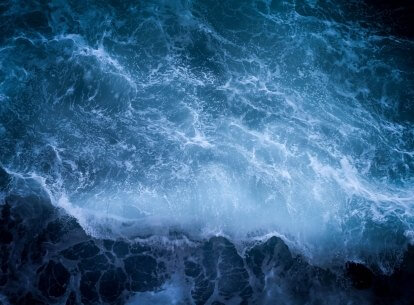
Why is the Water Gone?
Water is a scarce resource, with only 0.25% of earth's water being potable for human use2. In the United States, excessive water consumption of 39 billion gallons per day has strained freshwater resources and led to decreased reservoir water levels3, forcing states to make drastic cuts on water consumption4. Population growth and urbanization have further increased water demand, particularly in buildings5.
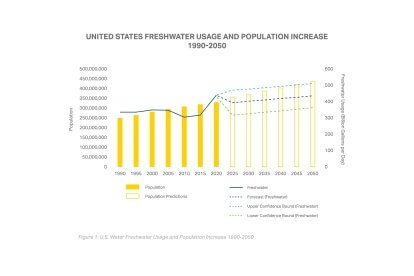
According to a report by National Intelligence Council in 20216, by 2050, water usage is projected to increase by 20 to 50 percent due to population growth (Figure 1).
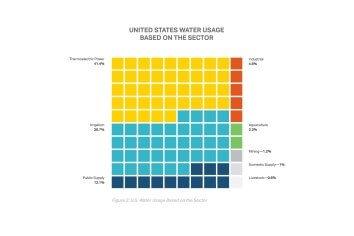
U.S. Water Withdrawal
Concerns about water scarcity and environmental impact have led to a focus on water-saving strategies in building design. In 2020, a study by St. Johns River Water Management District found that the US consumes 440,921 million gallons of water per day, with 87% of it being freshwater7. This is a sharp increase compared to 2015, largely due to the pandemic. A breakdown of the water usage per category8 is shown in Figure 2.
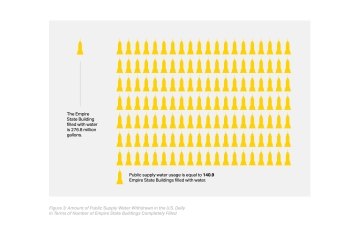
Water Usage in Context
Public supply water usage 7 – the water used for domestic and commercial use – in buildings, which is the third largest water consumption sector in United States, was recorded as 38,999.4 million gallons per day in 2020. Our previous work9 addressed how the farming industry can save 36% of water usage in irrigation, the second largest water consumption sector, through innovative approaches like vertical farming.
Diving into the Numbers
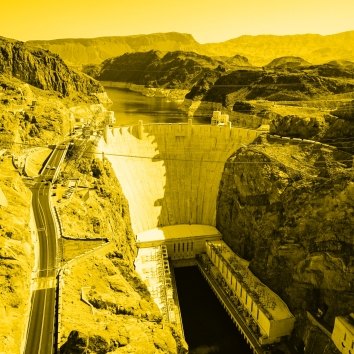
39 Billion
Gallon daily public water usage of Americans.
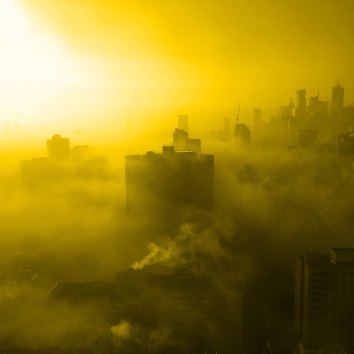
290 Million
MT CO2 produced annually to transport, process, and utilize water for commercial and residential buildings in USA.
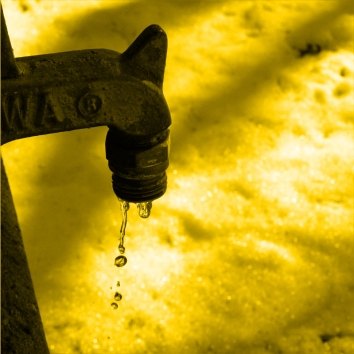
40%
Daily water in United States wasted due to leakage and overuse.
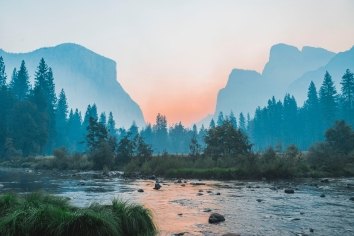
Sustainable Transformation
As mentioned previously, around 40 billion gallons of water is used every day in the United States. It is important to consider the environmental impact associated with the transportation, processing, and utilization of such a vast amount of water. One notable aspect to consider is the amount of CO2 emissions generated during these water-related activities. The handling and treatment of water, including pumping, purification, and distribution, often require energy-intensive processes that contribute to greenhouse gas emissions. It has been estimated that these processes collectively produce an annual carbon footprint of approximately 290 million metric tons of CO210
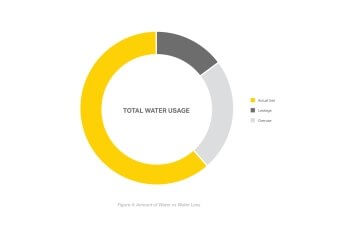
Designing for Efficiency
Architects and designers understand where water is planned to be used – but rarely do they consider where it will be misused. Around 13-15% of water use is the United States is wasted due to leaks within the appliances and/or the indoor plumbing system, and an additional 15-39% is wasted due to overuse of the water which stems from occupant behavioral patterns, such as letting the faucet run for too long 12 (Figure 4).
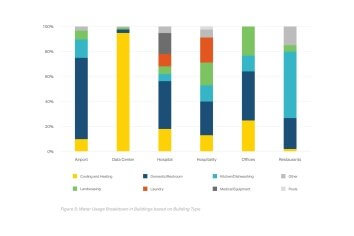
Most of the water in buildings is being consumed in the kitchen and the restroom11, indicating that most water usage is highly dependent on the users’ behavior and consumption pattern. A factor which only tends to increase, especially after the 2020 pandemic and the increase in remote working, where people work from the comfort of their home.
Hydration Hacks
We can reduce water usage in two major ways. First by implementing technical measures, including network improvement, leak repairs, and developing and integrating water-efficient appliances. Second, using non-technical measures such as providing users with access to information, education, and awareness that may change consumptive habits.
With the growing demand on water, there is a dire need for the implementation of innovative technologies that contribute to water conservation efforts. The use of artificial intelligence (AI) for water reduction in buildings has gained increasing attention in recent years to improve the efficiency and effectiveness of water management systems as it can monitor water usage by utilizing flow sensors in residential and commercial buildings. Flow sensors can be deployed in pipelines to measure the water flow data, which then streams to the cloud. This helps in designing efficient water utilization methods 13, aids in monitoring, and helps control levels of water usage. Aside from sensors, our buildings can also be designed to save water in three distinct ways
GREYWATER RECYCLING
The leftover water from washing machines and kitchen and restroom sinks that has not been in contact with any fecal contamination can still be repurposed for secondary uses in the building. A strategically designed distribution system can collect greywater from the building to apply treatment, instead of directly entering it into the sewer. This recycled water can be put back in the building, becoming an additional source of water for non-potable purposes such as landscaping and irrigation, thus developing an alternative source for consumption and saving the limited freshwater source 14.
RAINWATER HARVESTING
Across climate zones and varying amounts of annual precipitation, the optimal shape and orientation of the building or collection of buildings and various horizontal surfaces can directly contribute to the efficiency of rainwater capture 15. It’s therefore extremely important to consider using the building form to maximize the amount of rainwater catchment – especially in drier climates – as early as the conceptual and schematic phases of the design process. An example of maximizing rainwater harvesting through design is the roof of The Edge in Amsterdam, designed by PLP architecture firm (Figure 6), which has created a reservoir for gathering the rainwater to supply the toilet water for the whole building as well as the garden irrigation need 16. The Specific geometry shape orientation, direction and the slope of the Edge building makes it possible to maximize the amount of rainwater harvesting. This building uses the collected rainwater for the flushing system of all their toilets as well as gardening the landscape.

Source: Ronald Tilleman, PLP Architecture 17
LANDSCAPE AREA
In addition to harvesting rainwater from a building's roof, optimal locations for large-scale rainwater harvesting systems on the ground can be identified by combining various socio-environmental characteristics, such as elevation, slope, precipitation, temperature, distance from the river, land use, geology, soil type, population density, distance from roads, and lakes. Along with the use of artificial intelligence algorithms, these strategies can be incorporated into the site's landscape design18.
Actively designing to reduce the amount of turf area, while also considering using mulch and native plants, can reduce the amount of water needed for irrigation. Additionally, designers should consider using porous materials for any hard surfaces, such as permeable paving, which is a range of sustainable materials and techniques with a base and sub-base that allow the movement of storm water through the surface. In addition to reducing runoff, permeable paving effectively traps suspended solids and filters pollutants from the water. By allowing the water to seep into the ground, the direct and surrounding areas will need much less mechanical irrigation intervention, saving money and ultimately reducing the amount of water used for everyday irrigation needs.
WATER-EFFICIENT APPLIANCES
Using Energy Star-rated appliances in the building, such as dishwashers, washing machines, low-flow toilets, showerheads, and faucets, has been shown to reduce water usage, and in most cases resulting in at least a 20% water savings 19.
WATER QUALITY MONITORING
There are numerous chemicals in the water, some which can be harmful to our body, leading to many illnesses such as nausea, headache, vomiting, and even death. Therefore, it is vital to evaluate the quality of the water that we use 20. Manually extracting water samples across multiple sites and then sending those samples to a lab for further testing costs time and money, and can result in delayed, point-in-time information. And because a manual extraction cannot sample the exact same location and depth each time, it’s also inaccurate. However, AI-based algorithms can be used to actively monitor water quality in buildings and track key metrics by analyzing sensor data to detect and alert potential issues such as contamination or bacterial growth. Additionally, AI can improve how water resources are managed, by training machine learning models to forecast water quality using water data from hydro-electric powerplants 21. Companies such as Saafwater, monitor water quality in real-time to forewarn anomalies, while also recommending purification methods to improve it. The platform also provides water quality forecasts to enable proactive safety measures 22.
FASTER MAINTENANCE
AI is also being leveraged by engineers and water management authorities to keep water equipment and pipeline networks in the right order and provide cost-effective maintenance solutions. Pipebots, a UK-based project, aims to develop AI-powered micro-robots to analyze the state of underground pipelines and affordably repair them. Similarly, IBM, a global technology company, has utilized AI and machine learning to develop an in-pipe inspection prototype named Sewer Spy to find erosion and corrosion of pipelines 23. Emagin is another industry example using data analytics and machine learning to provide operators with the ability to make decisions and forecasting based on data from real-time sensors 24.
LEAK DETECTION
Plumbing leaks can create a moist environment within buildings – an ideal situation for bacteria and mold growth – which have many negative health effects on occupants. AI algorithms can be used to analyze sensor data to detect leaks in plumbing systems, which can lead to significant water savings and prevent any health risks. WaterSignal is currently one of the tools used in order to collect real time data of water usage of a building. This would help in water management and identifying any abnormal water usage, which can be a result of a leak 25. Additionally, each fixture creates a unique type of sound frequency based on the water usage and flow. Phyn’s direct leakage detection technology through sound 26 utilizes high-definition ultrasonic sensors to sample the pressure in the plumbing system 240 times every second. This produces an unparalleled view of the unique signatures of each fixture in the residential unit 27.
IRRIGATION CONTROL
Currently, there are different type of irrigation methods for landscapes, the most tradition system is manually watering the garden area and the grass area, other methods include using sprinklers in the area, drip irrigation. However, all these methods are prone to error as the timing and the amount of the water usage are set by users. With the conventional methods, around 50% of the water in outdoor landscaping is wasted due to due to wind, evaporation, and runoff caused by inefficient irrigation methods and systems 19. To reduce this amount of waste, companies such as CloudRain 28 and Eve 29 have been employing novel AI-based algorithms to control optimizing irrigation water usage based on weather conditions, soil moisture, and plant needs.
WATER USAGE OPTIMIZATION
AI-based algorithms can be used to optimize the use of water in buildings, by controlling and adjusting the flow of water in real-time based on the occupancy and usage patterns collected from previous data points such as utility bills. Clustering the water consumption into different groups based on their main usage (e.g., toilet, sink, shower, etc.) can help to detect abnormal water usage in each area 30.
USER BEHAVIOR
Achieving water consumption reduction goals requires the engagement of building occupants in the water conservation program, which is frequently one of the easiest and most affordable tactics to adopt. Currently, educational programs for improving the water usage of occupants inform users about the importance of water conservation and provide them with information and tools to reduce their water consumption with pamphlet distribution, incentive programs (such as water pricing), creating hot lines to report leaks, and displaying the water management to the public 31. AI-based behavioral change technologies can be used to promote energy savings in residential and office buildings. They can also understand the consumers’ demand and usage patterns for providing the most optimized response through controlling the flow of water in plumbing systems 30. By combining IoT water micrometers in all water points with SaaS dashboard 32 to notify the user if the appliances were left on, data-driven transparency on water usage can be created. Using AI controllers for water appliances and pipes can lead to a considerable amount of energy cost saving 33.
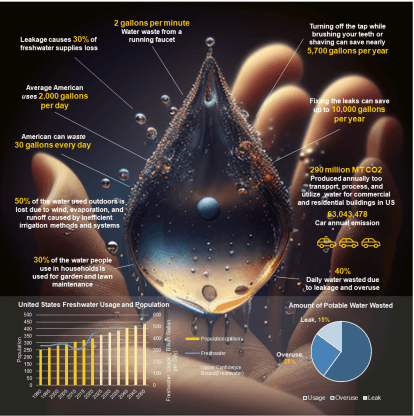
The Power at the Palm of Your Hand
Technology-based strategies such as using energy efficient appliances are more common and widely studied than behavioral solutions. Nonetheless, it is imperative to acknowledge the significance of incorporating behavioral strategies, as they possess the potential for greater cost-effectiveness. While many of the current water conservation techniques rely on the technical measures, the future of water conservation will be more reliant on non-technical measures. By using IoT technologies, we can modify people’s water consumption behavior. Similarly, integrating AI into building management systems has the potential to greatly reduce water consumption and improve the efficiency of water usage. By analyzing data on water usage patterns and identifying areas of inefficiency, AI algorithms can optimize water usage and detect leaks in real-time. This can lead to significant savings on water bills and reduce the environmental impact of buildings.
The use of AI in water management in buildings has the potential to improve the efficiency and effectiveness of water management systems, leading to significant water savings. However, the implementation of AI in water management systems also requires a significant investment and it's important to consider the impact on privacy, from an ethical perspective.
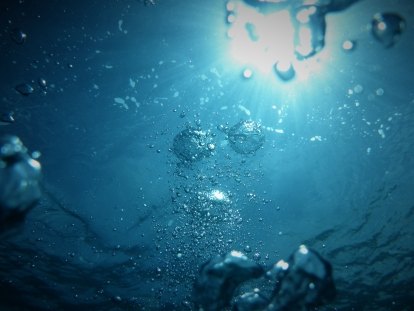
Figure 7 show the current and future techniques various areas of the built environment can leverage for optimal water conservation. One salient difference here is how future design techniques for water conservation such as leveraging new technologies and AI, has targeted behavioral change as part of the building itself. This is in stark contrast to the current behavioral programs currently used such as pamphlets and flyers, as mentioned earlier in the article. A future building will be the hub for interconnected sensors that read the water usage by each appliance, showing each occupant their trend of usage in real-time. Building owners will have the ability to control the water flow for different parts of the buildings, setup landscape watering schedules based on the weather forecast, and be notified of any leak or pipe burst as soon as it occurs.
In summary, while technology-based strategies such as energy efficient appliances are more commonly studied, behavioral solutions can be more cost effective for water conservation. The future of water conservation will rely more heavily on non-technical measures, such as IoT technologies and AI algorithms. The implementation of AI in water management systems has the potential to significantly reduce water consumption and environmental impact, although it requires a significant investment and ethical considerations. The building of the future will be a hub for interconnected sensors and kiosks, allowing occupants and owners to monitor and control water usage in real-time.
References
- Lystra, Tony. (2022, July 11).” To solve the water crisis, companies are increasingly turning to AI”. Fortune. Retrieved from. https://fortune.com/2022/07/11/companies-are-increasingly-turning-to-ai-to-help-mitigate-the-water-crisis/
- Delaurentis, Marabelle, (2021, March 25). “Why Should We Turn Off the Tap Water When Brushing Our Teeth?”. Retrieved from https://sites.psu.edu/marabelleolivia/2021/03/25/why-should-we-turn-off-the-tap-water-when-brushing-our-teeth/
- Environmental Protection Agency. (2022, May 24,). “How We Use Water”. EPA, Retrieved from https://www.epa.gov/watersense/how-we-use-water
- Glennon, Robert. “What Is Dead Pool? A Water Expert Explains”. (May 15, 2022). Governing. University of Arizona. Retrieved from https://www.governing.com/now/what-is-dead-pool-a-water-expert-explains
- Antunes, L. N., Thives, L. P., & Ghisi, E. (2016). Potential for potable water savings in buildings by using stormwater harvested from porous pavements. Water, 8(4), 110.
- National Intelligence Council. (2021, November 18,). “Water Insecurity Threatening Global Economic Growth, Political Stability.” Water Insecurity Threatening Global Economic Growth, Political Stability. Retrieved February 2, 2023 from https://www.dni.gov/files/images/globalTrends/GT2040/NIC_2021-02489_Future_of_Water_18nov21_UNSOURCED.pdf
- St. Johns River Water Management District. (2023). Technical Fact Sheet SJ2022-FS1 2021 Report of Annual Water ... - SJRWMD.” Document Library, Retrieved from https://clone.sjrwmd.com/static/facts/technicalreports/2021-AWUS-Factsheet_Final.pdf.
- Dieter, C. A., & Maupin, M. A. (2017). Public supply and domestic water use in the United States, 2015 (No. 2017-1131). US Geological Survey
- Hugo. (2022, February) “Vertical Farming, A Case for On-site Food Production”, The 2022 Curiosity Report; Designing with New Energy, https://www.corgan.com/sites/default/files/inline-files/Corgan2022CuriosityReport.pdf
- Ro, C. (2022, February 24). The hidden impact of your daily water use. Retrieved March 15, 2023, from https://www.bbc.com/future/article/20200326-the-hidden-impact-of-your-daily-water-use
- Environmental Protection Agency. (2022, August 29). “Data and Information Used by WaterSense.” EPA. Retrieved from https://www.epa.gov/watersense/data-and-information-used-watersense#End%20Uses%20of%20Water
- Environmental Protection Agency. (2022, May 24). “How We Use Water”. EPA. Retrieved from https://www.epa.gov/watersense/how-we-use-water
- Sharma, R., & Gundraniya, V. (2020). Artificial Intelligence towards Water Conservation: Approaches, Challenges, and Opportunities. Artificial intelligence and machine learning applications in civil, mechanical, and industrial engineering, 141-151.
- Radingoana, M. P., Dube, T., & Mazvimavi, D. (2020). Progress in greywater reuse for home gardening: Opportunities, perceptions and challenges. Physics and Chemistry of the Earth, Parts A/B/C, 116, 102853.
- Şahin, N. İ., & Manioğlu, G. (2019). Water conservation through rainwater harvesting using different building forms in different climatic regions. Sustainable Cities and Society, 44, 367-377.
- Randall, Tom. (2015, September 23). “The Smartest Building in the World Inside the Connected Future of Architecture.” Bloomberg.com. Bloomberg, Retrieved from https://www.bloomberg.com/features/2015-the-edge-the-worlds-greenest-building/.
- Roland Tilleman, PLP Architecture. (n.d). Retrieved July 19, 2023, from https://tinyurl.com/m8t8uyyy
- Darabi, H., Moradi, E., Davudirad, A. A., Ehteram, M., Cerda, A., & Haghighi, A. T. (2021). Efficient rainwater harvesting planning using socio-environmental variables and data-driven geospatial techniques. Journal of Cleaner Production, 311, 127706.
- United states Environmental Protection Agency. (2022, May 11). “Statistics and Facts.” EPA. Environmental Protection Agency. Retrieved from https://www.epa.gov/watersense/statistics-and-facts
- Vasistha, P., & Ganguly, R. (2020). Water quality assessment of natural lakes and its importance: An overview. Materials Today: Proceedings, 32, 544-552.
- Chen, K., Chen, H., Zhou, C., Huang, Y., Qi, X., Shen, R., ... & Ren, H. (2020). Comparative analysis of surface water quality prediction performance and identification of key water parameters using different machine learning models based on big data. Water research, 171, 115454.
- Saafwater. (2022). Making the invisible water quality, visible, Retrieved from https://www.saafwater.com/
- AIWS. (2021, January 27). “Saving Water with Artificial Intelligence.” AIWS. Retrieved from https://aiworldschool.com/research/saving-water-with-artificial-intelligence/
- Innovyze. (2023). “Emagin.” Predictive Control Using AI. Retrieved from. https://innovyze.com/products/ai-operational-analytics/emagin/https://www.innovyze.com/en-us/products/emagin
- WaterSignal. (2023).” How it Works”, Retrieved from https://www.watersignal.com/about/how-it-works/
- Seyoum, S., Alfonso, L., Van Andel, S. J., Koole, W., Groenewegen, A., & Van De Giesen, N. (2017). A Shazam-like household water leakage detection method. Procedia Engineering, 186, 452-459. https://doi.org/10.1016/j.proeng.2017.03.253.
- Phyn. (2022, September 9). “Patented HD Water Pressure Sensing Detects Pipe Leaks Big and Small.” Your water like you’ve never seen it. Retrieved from https://www.phyn.com/technology/
- CloudRain. (2022). “Smart Home? Smart Garden!” Your smart garden irrigation. Retrieved from https://cloudrain.com/
- Eve. (2022). “Eve Aqua.” Eve Weather. Retrieved from https://www.evehome.com/en-us/eve-aqua
- Himeur, Y., Elnour, M., Fadli, F., Meskin, N., Petri, I., Rezgui, Y., ... & Amira, A. (2022). AI-big data analytics for building automation and management systems: a survey, actual challenges and future perspectives. Artificial Intelligence Review, 1-93.
- Bourg, Joseph. (2016, July 11) “Water Conservation.” WBDG, July 11, 2016. Retrieved from https://www.wbdg.org/resources/water-conservation
- DrizzleX. (2022). “Water Submetering: United States.” High Resolution Smart Water Management. Retrieved from https://www.drizzlex.com/
- Pavithra, Rao. (2021, February 07).” How AI Is Transforming The Water Sector”. Retrieved from https://inc42.com/resources/how-ai-is-transforming-the-water-sector/






